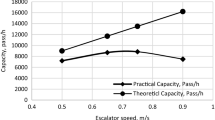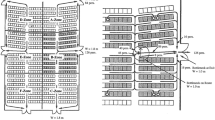Abstract
This paper discusses the analysis of flow characteristics on escalators and examines the adequacy of step size. The study was carried out on nine escalators at three metro stations in New Delhi, the capital city of India. Data were collected during morning and evening peak flow periods. Peak flows on the escalators being studied are observed to be higher during evening period as compared to the morning period. Flow values are quite high when compared with flow values at metro stations in China or England or on similar facilities at railway stations. Maximum density was found higher as compared to that reported in China and England and comparable to that at railway stations in India. Space per person was found comparable to the reported values. Relationships between flow characteristics were also developed. Step dimension adequacy was checked and suggested to be modified in the light of person body dimension reported in different guidelines. The outcome will assist the planners to take considered decisions related to escalators.
Similar content being viewed by others
References
Al-Sharif L (1996) Escalator handling capacity: Standards versus practice. Internal Report, London Underground Ltd.
Bodendorf H, Osterkamp M, Seyfried A, and Holl S (2014) Field studies on the capacity of escalators. Transportation Research Procedia 2:213–218
BS 5656-2:2004 (2004) Escalator and moving walks — Safety rules for the construction and installation of escalators and moving walks, Part 2: Code of practice for the selection, installation and location of new escalators and moving walks. BS 5656-2:2004, British Standards Institution, London, UK
Bureau of Public Roads (1964) Traffic assignment manual. U.S. Department of Commerce, Washington DC, USA
Cheung CY, Lam WH (1998) Pedestrian route choices between escalator and stairway in MTR stations. Journal of Transportation Engineering 124(3):277–285, DOI: https://doi.org/10.1061/(ASCE)0733-947X(1998)124:3(277)
Davis P, Dutta G (2002) Estimating of capacity of escalators in London Underground. Working Paper No 2002-11-01 from Indian Institute of Management Ahmedabad, Research and Publication Department, Ahmedabad, India
DIN EN 115-1:2017 (2017) Safety of escalators and moving walks — Part 1: Construction and installation. DIN EN 115-1:2017, German Institute for Standardization, Berlin, Germany
Fruin J (1987) Pedestrian planning and design, revised edition. Elevator World, Inc., Educational Services Division, Mobile, AL, USA, 89–114
Highway Capacity Manual (2010) Chapter 23. Off-street pedestrian and bicycle facilities. Transportation Research Board, Washington DC, USA
Indian Highway Capacity Manual (2017) Chapter 9. Pedestrian facilities. Council of Scientific and Industrial Research (CSIR), New Delhi, India, 1–36
IS:4591-1968 (1968) Code of practice for installation and maintenance of escalators. IS:4591-1968, Bureau of Indian Standards, New Delhi, India
Kinsey M, Galea ER, Lawrence P (2012) Modelling evacuation using escalators: A London Underground dataset. In: Weidmann U, Kirsch
U, Schreckenberg M (eds) Pedestrian and evacuation dynamics 2012. Springer, Cham, Switzerland, 385–399, DOI: https://doi.org/10.1007/978-3-319-02447-9_32
KONE Corporation (2009) Planning guide for people flow in transit stations. KONE Corporation, Retrieved June 6, 2020, https://www.kone.com/
Lam WHK, Cheung CY (2000) Passenger speed/flow relationships for walking facilities in Hong Kong. Journal of Transportation Engineering 126(4):343–349, DOI: https://doi.org/10.1061/(ASCE)0733-947X(2000)126:4(343)
Li B, Li M (2014) Research on passenger capacity of escalator in the hub. Applied Mechanics and Materials 505–506:650–655, DOI: https://doi.org/10.4028/www.scientific.net/AMM.505-506.650
Mayo AJ (1966) A study of escalators and associated flow systems. MSc Degree Report, Imperial College of Science and Technology, London, UK
Nai W, Dong D, Chen S, Zheng W, Yang W (2012) Optimizing the usage of walking facilities between platform and concourse layer in L-shaped interchange metro station. Procedia — Social and Behavioral Sciences 43:748–757, DOI: https://doi.org/10.1016/j.sbspro.2012.04.148
National Building Code of India (2016) Volume 2, Part 8: Building services, Section 5: Installation of lifts, escalators and moving walks, 5b: Escalators and moving walks, Clause 4.3, 4.4. Bureau of Indian Standards, Ministry of Consumer Affairs, Government of India, New Delhi, India
Oeding D (1963) Traffic loads and dimensions of walkways and other pedestrian circulation facilities. Strassenbau and Strassenverkehrstechnik 22:160–163
OTIS (2012) Planning guide for elevators. Escalators and Trav-o-lators, OTIS India Communications, Mumbai, India
Patra M, Sala E, Ravishankar KVR (2017) Evaluation of passenger flow characteristics across different facilities inside a railway station. Transport Research Procardia 25:4763–4770, DOI: https://doi.org/10.1016/j.trpro.2017.05.488
Sala E, Ravishankar KVR (2016) Capacity analysis of escalator: A case study of Vijayawada railway station. In: International conference on transport planning and implementation methodologies for developing countries, 12th TPMDC, December 19–21, Mumbai, India
Schindler Escalators and Moving Walks (2020) Planning guide for escalators and moving walks. Jardine Schindler Group
Sukor NSA, Nain FHM, Ismail I, Ismail MAM (2018) Analysis of passenger walking characteristics at vertical facilities in underground train station. IOP Conference Series: Materials Science and Engineering 352(1):012–031
TCRP Report 165 (2013) The transit capacity and quality of service manual. Transportation Research Board, Washington DC, USA, 5–25
ThyssenKrupp Escalators Americas (2011) Escalators and moving walks — Planning guide. ThyssenKrupp Escalators, Düsseldorf, Germany
Union International des Transports Publics (2018) World metro figures: Statistics brief. Advancing Public Transport, Brussels, Belgium
Weidmann U (1993) Transporttechnik der fussgänger — transporttechnische eigenschaftendes fussgängerverkehrs (literaturstudie). Literature Research 90:68–73
Xiang Z, Wai FK, Chor CH (2003) Passenger speed-flow model on escalators and staircases in Singapore MRT stations. Department of Civil Engineering, University of Singapore, Singapore
Acknowledgments
The authors would like to acknowledge Delhi Metro Rail Corporation (DMRC) for the permission given for video recording at metro stations.
Author information
Authors and Affiliations
Corresponding author
Rights and permissions
About this article
Cite this article
Kahali, D., Rastogi, R. Analysis of Flow Characteristics and Step Size of Escalators at Metro Stations. KSCE J Civ Eng 25, 1043–1055 (2021). https://doi.org/10.1007/s12205-021-1142-2
Received:
Revised:
Accepted:
Published:
Issue Date:
DOI: https://doi.org/10.1007/s12205-021-1142-2




